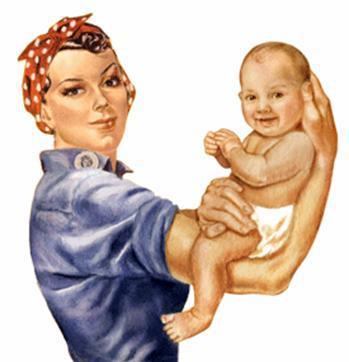 This week Facebook unveiled a feature for users to announce their pregnancy via their Facebook profile. A quick scan of Twitter reactions to the addition, however, shows that many are skeptical, even repulsed, by the new measure because it facilitates exploitation of private family life for advertising purposes. Perhaps, but only if you assume that pregnancy and motherhood are entirely private affairs meant to be separate from the rest of economic life.
This week Facebook unveiled a feature for users to announce their pregnancy via their Facebook profile. A quick scan of Twitter reactions to the addition, however, shows that many are skeptical, even repulsed, by the new measure because it facilitates exploitation of private family life for advertising purposes. Perhaps, but only if you assume that pregnancy and motherhood are entirely private affairs meant to be separate from the rest of economic life.
Having children is life-changing for women’s personal lives as well as their public and professional lives. Ignorance or dismissal of that reality may be a barrier to women’s empowerment in public and in the workplace.
Policies regarding maternal leave, for example, vary by country and firm. Inadequate policies that do not match women’s needs can hamper their careers, their ability to provide for their families, their companies’ diversity, and, where women hold leadership positions, the bottom line. By allowing pregnancy and motherhood to slow women’s participation in the public sphere, countries miss out on the benefits of having women in office, such as increases in spending on education and decreases in corruption.
So why divorce family matters from discussions of public life for women?
Cultural and social expectations often place great pressure on women to become mothers and stay at home with their children. Societies seeking to unlock the potential of half of their population, however, will need to think critically about how to work with women to balance their maternal, economic and political goals.
By not addressing the ways that women’s family and professional roles are related, policymakers may inadvertently delay progress towards gender equality. According to the World Economic Forum’s Global Gender Gap Report, there remains a wide gap between women and men in economic and political participation. Only 59 percent of the economic outcomes gap and 18 percent of the political outcomes gap have closed. Women’s rate of participation in Parliaments is hovering around 18 percent, there are fewer than 20 women heads of state or government, and women hold about 16 percent of ministerial duties.
Some governments address maternal policies directly. For example, Norwegian law mandates that women hold 40 percent of boardroom seats in Norway. Nine out of 10 men take off time from work to look after their children, allowing women to go back to work sooner. The state subsidizes the cost of daycare. According to a labor economist at the Organization for Economic Cooperation and Development, these policies are expensive but their cost is offset by returns in female labor supply and tax revenue.
In France, families enjoy free preschools, family allowances, tax deductions for each child, and a paid four-month maternity leave, among other things. Tax dollars pay for these programs, which in turn benefits French society by boosting employment rates, increasing tax revenue, and supporting the development of France’s future workforce and taxpayers.
Despite those programs, France ranks 46th in the World Economic Forum’s 2010 gender equality report, behind the United States, most of Europe, as well as Kazakhstan and Jamaica. The reason for this lag may relate to a deeply embedded sense of machismo in French society, exemplifying the importance of culture to women’s empowerment, with or without children.
It may not be possible or even desirable for other societies to duplicate Norway’s or France’s strategies for helping women continue their livelihoods after becoming mothers. Companies and governments may want to take note of the positive outcomes, though.
In the private sector, companies that hire and retain more women have a competitive edge according to The McKinsey Quarterly. McKinsey also suggests that when Human Resources are identifying high-potential employees, they broaden their parameters to include the number of years of employment, not just employees’ ages. That way, investigations do not penalize women who have taken time off for maternity leave.
At a panel on women and leadership at CIPE’s conference Democracy that Delivers for Women, participants talked about some of the barriers to women’s participation, such as discrimination, lack of networking opportunities, and low confidence. What participants didn’t fully develop was how family obligations relate to women’s empowerment in developing countries. Since many women micro-entrepreneurs work from home, are they relieved from some of the difficult decisions that others have to make regarding how they budget their time?
As those women entrepreneurs grow their businesses, it is important that some structures exist to support their growth without ignoring the rest of their familial duties. No matter where the support comes from, be it kin, business, or the state, increasing women’s participation is essential for women’s empowerment. Strategies for working mothers may be worth exploring as women around the world strive to become more involved in policymaking and business.

